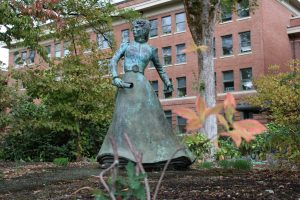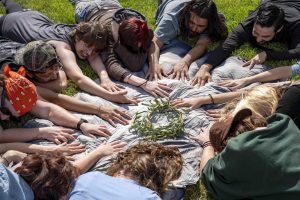Allergy season in Corvallis
March 7, 2019
As the winter passes, spring rises. The flowers are blooming, trees regrow their leaves and the temperature gets warmer. Corvallis is no stranger to this and with the springtime also comes allergy season.
“In Oregon, there’s an allergy all year-round.” said Diana Scott, a board-certified family nurse practitioner for the Quick Care clinics in both Corvallis and Albany. “Most commonly, what people are talking about is the early spring and summer season when things start blooming. The allergen that’s causing you that reaction may or may not be as present in the environment during particular times of the year,” Scott said.
People have different types of allergies of all kinds, depending on the allergens present in the area and the time of year. Even with the different seasons that present different allergens, people can display similar symptoms when exposed to these allergens.
“In the summer, the most common thing we see are the red itching eyes, the running nose and the asthma exacerbations. In the winter time, we might see those same things. We might also see itching skin rashes,” Scott said.
Allergens are everywhere and it’s good to know what exactly about them causes allergies. It’s also important to understand how to protect against these airborne allergens. Cassandra Johnston is a registered nurse for Student Health Services (SHS) at Oregon State University explained exactly happens to the body during an allergic reaction.
“Allergic reactions happen when the body comes into contact with a something such as a food or an airborne particle, that it identifies as harmful. Your body then produces antibodies called immunoglobulin E (IgE) that attach themselves to certain cells, causing the cells to release a chemical called histamine. The histamine, in turn, causes inflammation, producing classic seasonal allergy symptoms, like red, watery eyes and itching (Niya Jones, MD, 2015),” Johnston stated in an email.
Johnston also took the time to list out ways people can protect themselves from being exposed to a large amount of allergens, as well as ways to better protect against it.
“Avoiding outdoor exercise and activities when pollen counts are high, especially in the early morning on dry, breezy days. Showering before bed after being outside helps remove pollen and other allergens from hair, skin, eyebrows and lashes. Wearing glasses when outside helps keep pollen from getting in eyes,” Johnston said.
Pollen tends to be the most common cause for allergic reactions during the springtime, according to Johnston. Certain pollinators, such as Trees, “generally pollinate from December through April. The next pollinators are grasses. Usually, the grass season is at its peak from Memorial Day (end of May) to Fourth of July, but depending on the climate can shift a little earlier or a little later. Another group of pollinators is weeds. Typically, these pollinate toward the end of summer and into fall, until first frost. People who have allergies to perennial allergens such as feathers, animal dander, dust mites or mold may have symptoms year-round and symptoms may be worse during colder weather with increased indoor exposure,” Johnston said.
While there may be enough types of allergens in the air that can cause allergic reactions, there are plenty of different ways to deal with them. According to Scott and Johnston, people can employ preventative measures, such as showers after being outside, to reduce their chances of getting sick during the blooming season.
If symptoms persist and people are worried about their health, there are also resources available that can help out. Students can be seen at SHS for allergy symptoms, while others can go to the local Quick Care for same-day appointments.
The SHS also has a podcast called ‘To Your Health’, which is oriented towards students who are interested in health resources on-campus. For a link to their episodes, visit https://studenthealth.oregonstate.edu/podcast.






